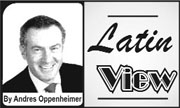Following the surprise results of Colombia’s peace referendum and Britain’s Brexit vote — in which most polls turned out to be wrong — one has to ask whether something similar could happen in the US elections. And the answer is yes.
 The reason I’m fearful that Donald Trump could win despite Hillary Clinton’s current four-point lead in the polls — yes, I think Trump would be an unstable, erratic and dangerous president — is simple: Polls are not what they used to be.
The reason I’m fearful that Donald Trump could win despite Hillary Clinton’s current four-point lead in the polls — yes, I think Trump would be an unstable, erratic and dangerous president — is simple: Polls are not what they used to be.
“Every day, it’s becoming more difficult to conduct scientific polls, and to obtain credible results, especially when we’re talking of telephone surveys,” veteran pollster Sergio Bendixen, founder of the Bendixen & Amandi polling firm, told me. “People are fed up with getting calls from pollsters, and many don’t respond anymore.”
Bendixen, who started doing polls 40 years ago, says that the percentage of people answering calls from pollsters has dropped dramatically in recent decades.
While about 80 per cent of Americans responded to calls from polling firms five decades ago, only about 30 per cent today respond to calls made by real people working for polling firms, and about 10 per cent answer automated calls, he says. Most of us simply are simply hanging up when we get an automated call from a polling firm.
“The polling business is in crisis,” Bendixen said. “Even those who tell polling firms that they are likely voters are often lying. Many people are embarrassed to tell somebody else that they are not going to vote.”
Nate Silver, the former New York Times statistics whiz who successfully predicted the outcomes of all 50 states in the 2012 elections and now is the editor in chief of FiveThirtyEight.com, conceded last year that “polling is getting harder.”
“Response rates to telephone surveys have been declining for years and are often in the single digits,” he wrote. “The relatively few people who respond to polls may not be representative of the majority who don’t.”
In Colombia, the most important polling firms — Gallup, Ipsos Napoleon Franco, and Cifras y Tendencias — had predicted that the pro-peace deal vote would win by a 24- or 30-percentage point margin. Another firm, Datexco, forecast the narrowest lead for the “yes” vote, of 55 per cent to 37 per cent.
After the vote in Colombia, many analysts said that the “no” vote had won because complacency among the “yes” voters meant many stayed at home. In addition, a high abstention rate, the fact that supporters of the “no” vote were more motivated than their rivals, and bad weather in coastal zones where the “yes” vote was strong also led to the upset, they say. But few mentioned that polls may be increasingly unreliable.
Asked whether the same could happen in the upcoming US elections, Bendixen told me, “Yes, but the difference is that in the United States you have many more professional polling firms than in other countries, which seek to survey representative samples of the population.”
While most countries have three or four good polling firms, there are about 15 such companies in the United States. When most of them show similar results, or trends, you can assume that they are right, he said.
“Today, most polls show that Clinton is ahead by four or five points,” said Bendixen, who has worked mostly for Democratic candidates. “But could Trump win? It’s not likely, but it’s possible.”
My opinion: I agree. Like in Colombia, there is a possibility that on November 8 we could see a higher than normal abstention rate, and a generalized complacency by Clinton’s voters that would lead many of them to stay at home.
Add to that the fact that Trump supporters are more motivated to go out and vote than Clinton’s and that election polls today are less accurate than in the past because fewer people respond to them, and the United States could still end up with its own version of a banana republic clownish autocrat.





